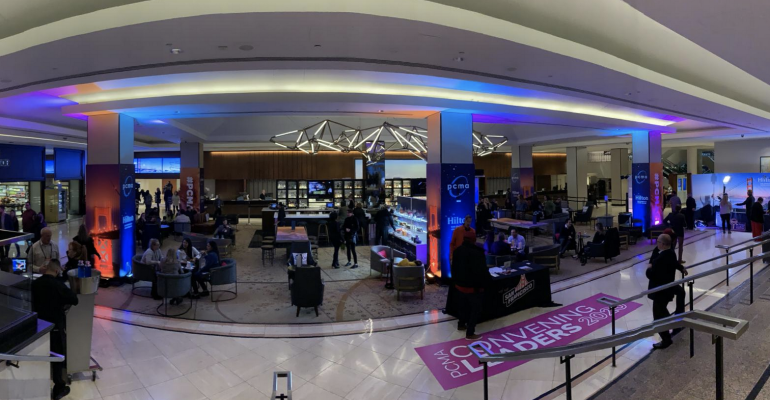A popular tactic for organizations looking to make a splash in their host destination during a user conference, customer event, or other external meeting is to use branded flags, banners, boards, clings, wraps, and other messaging tools. This achieves several goals, such as making attendees feel welcomed and important to the destination; letting the general public know that the group is in town and delivering economic benefit; and promoting the organization’s overall brand and its specific messaging for that event.
Sounds like a win-win for all parties involved, right? Not so fast. When it costs $1,500 per day simply to wrap a pillar in the prefunction space of a meeting venue—as it did for a recent association conference organized by Nancy Sutta Berns, program manager for Conference Management Services, Inc.—the benefits might not seem to justify the price.
A wall flag for $1,000 per day, an elevator cling for $800 per day, and floor space for a gobo lighting feature for $600 a day? Right now, all those figures are in the ballpark. And that’s only for the space; the costs to produce the promo materials themselves are additional.
While selling spaces for groups to brand has always been a revenue source for hotels, “the big hotel chains have ramped up prices and made it more difficult to negotiate because they’ve created chain-wide branding guides,” notes Tanna Pearman, meeting broker for Meetings Made Easy. “The independent hotels seem to be a bit more flexible with their prices.”
The one way Pearman gains some leverage with a headquarters hotel is by addressing branding opportunities and costs during the request-for-proposal process—before any property is assured of landing the biggest room block for the meeting.
 “It’s important to include your terms for branding opportunities in the RFP to see what you can get in concessions,” says Pearman (in photo), noting that hotels might negotiate a percentage off the branding guide’s listed price or offer some spaces as a value-add if you purchase enough at the listed rates. “This minimizes your surprise costs later in the planning process, and helps you figure out how much to charge sponsors for whichever spaces you want to make available to them.”
“It’s important to include your terms for branding opportunities in the RFP to see what you can get in concessions,” says Pearman (in photo), noting that hotels might negotiate a percentage off the branding guide’s listed price or offer some spaces as a value-add if you purchase enough at the listed rates. “This minimizes your surprise costs later in the planning process, and helps you figure out how much to charge sponsors for whichever spaces you want to make available to them.”
For example, “if you want to use branded room keys or key envelopes, the hotel will charge you about three dollars per item,” Pearman adds. “You need to factor that into the price you charge the sponsor who wants that opportunity.”
As for branding spaces outside the headquarters hotel, such as at the convention center, in the airport, and on the streets around those facilities, Pearman suggests pitching the convention and visitors bureau for financial assistance. “Many times, the CVB will have a subsidy available for big groups to tap into for signage in places outside the hotels,” Pearman says.
Strategic Placements
Sutta Berns says that for the scientific and medical events she coordinates, “we pick and choose where the most bang for the buck is going to be. For instance, the hotels’ branding guides have options for decals on bathroom mirrors in the meeting and exhibition areas. Well, that’s not going to be seen by as many people as a banner on the big wall behind the registration desk.”
Even for the 1,600-person event she coordinates in a convention center for one medical society, “I am only going to use a couple of spots for branding in the headquarters hotel and save my budget for other options, because a lot of attendees are not staying at the headquarters hotel. They’ll never see it.”
Lastly, Sutta Berns agrees with Pearman about having conversations as early as possible with all venues that could be sites for branding. “Especially if a program is driven by a board member or executive who wants to showcase his or her hometown, or you have an industry supplier who wants to showcase themselves in a particular way, you might have some leverage” by mentioning these factors early on.





